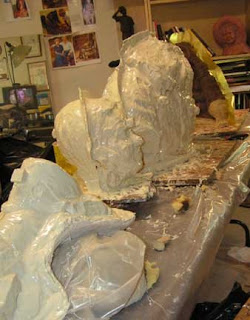Posts by admin
Another Trip To The Foundry
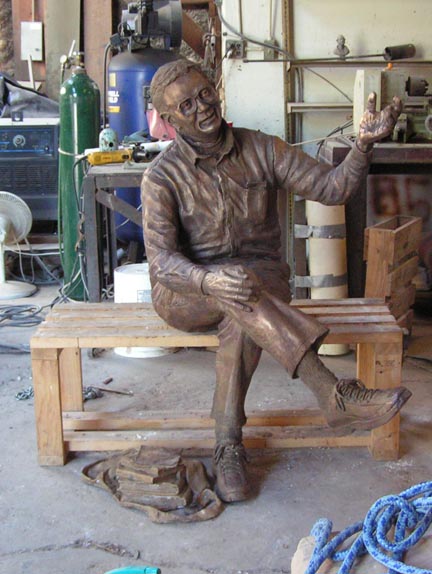
Between the bronze of Dick and the bronze of Jenna I have been going back and forth to the foundry every few days. Here is a view of the Hathaway piece upon last visit. Tuesday is patina day. I can’t wait.
I have heard it takes three men to lift thissculpture. Not sure how he is going to fit in an SUV but we will do our best.
You Could Lose Your Rights To All The Work You Have Ever Created
Created for Best of Artists and Artisans web site
By Bridgette Mongeon © 2008

Immediate action is needed concerning the
Senate Bill S. 2913 and House Bill H.R. 5889, the Orphan Works Acts of 2008.
America is known for the country that protects an individual’s rights. It is impossible for me to comprehend that my rights as an artist may soon drastically change, and that I could lose the rights to all the work that I have ever created. When I first heard about this, it was so unbelievable that I thought that it must be a prank. But, with further investigation I found it was not. In this article I will include a little about what I found and links with other articles for readers to peruse so that they can make their own informed decision. I am also setting up interviews with several people including Copyright lawyers, those in the writers unions, and even those in the American Federation of Television and Radio artists, to name a few. There is urgency in acting and spreading this information. For whatever reason, this is moving through congress quite quickly and will affect your rights and possibly your income as a creative person.
As I find more information and create these interviews, I will pass them on to the Editors at Best of Artists and Artisans sculpture blog to be posted at their discretion. I will also post all of the information that I find on my home page blog, located at https://creativesculpture.com/blog
COPYRIGHT LAW AS IT STANDS TODAY
First, a few basics about copyright law as it stands today. According to the copyright law of 1976, everything that you create is protected by copyright from the moment you create it, even if it is not registered. This is the way copyright is handled throughout the world. It was defined by the Berne convention, which is an international agreement concerning copyrights.
With the current Copyright law, you do need to register your work if you want to collect for statutory damages for infringement. If, however, your work is registered and you discover someone has stolen it and you file suit, statutory damages are punitive and can be quite severe for those infringing on someone’s rights. This very idea keeps many people honest about “taking” other people’s artwork.
“It is not what it appears to be, it is a Trojan horse… Under this orphan works legislation, nothing you do would be protected unless it is registered with these commercial registries… they are orphaning all unregistered work” Brad Holland
THE CHANGE IN LAWA radically proposed change to the US copyright law allows infringers to exploit the right of copyright holders with little or no penalty according to the Orphan Works Opposition Headquarters (OWOH). “Two bills currently on the “rocket docket” would let infringers “orphan” any copyrighted work whose owner the infringer failed to locate through a vaguely defined “reasonably diligent” search. The creative arts industry, including world-renowned artists, designers, photographers, manufacturers, and licensing businesses have united to oppose this legislation.”
The New Orphans Work Act declares that nothing you do would be protected unless you register it with a registry, placing a burden of diligence on the copyright owner. It must also be stated that even though these bills are moving quite fast through congress, registries do not, at this time, exist. These would be private registries where an artist would be responsible to register their art. In other words, every artist will have to pay to own their own work and each of their pieces will have to be registered, right down to the sketches in their sketchbook. If they are not and someone comes across your work and they search these directories and do not find it, then they can say that they performed a “reasonably diligent search.” They can use your work at no cost. As I comprehend the ramifications of this, the works that are presently copyrighted would also have to be reregistered. The cost of registering each piece of artwork, nevertheless the time that it would take to register each piece of artwork throughout an artists lifetime, makes this task impossible and prohibitively expensive.
It is interesting to note the following—It is a violation of the Berne Convention for the Protection of Literary and Artistic Works for any country to impose registration on a rights holder as a condition of protecting his copyright. See Article 5(2) “The enjoyment and the exercise of these rights shall not be subject to any formality (emphasis added).”, (From How the Orphan Works Bills Affect Visual Artists. Illustrators Partnership of American)
According to some of the interviews that I have listened to a creative person would also have to police their artwork, making sure that no one has taken it or it may be considered orphaned.” It is also said that you would have to reply to all inquiries on your artwork or it might be considered orphaned. All of this hardly leaves room for an artist to create.
OWOH states, “The new bills would severely “limit” financial penalties for infringing. Opponents charge this will encourage deliberate theft because statutory damages are the only tool the law gives copyright holders to prevent abuse– and they say it works. Penalties for infringement almost certainly deter rampant abuse by making it risky. But as medical illustrator Cynthia Turner notes ‘the new bills would protect infringers by denying artists damages, incurred court costs, attorneys’ fees and other expenses.'”
“Because these bills were planned behind closed doors, introduced with little warning and fast-tracked for imminent passage, a broad-based coalition of artists and trade associations say they have had little time to respond and generate public discussion. They say that a radical change in intellectual property law should not be rushed through Congress without public vetting. They are calling on Congress to slow down this legislation until it can be subjected to an open, informed and transparent public debate.”
Those in support of this bill are libraries and educators that claim that this bill is intended to give libraries and museums greater latitude to commercialize archived works. But, according to tp the OWOH, “critics charge the bills have been drafted so broadly they would permit any infringer to commercially exploit any copyrighted work, from professional art to family photos.” Those supporting the bill say that if artwork is worth something it should be registered. But if it is not worth something why would others want to take it?
Brad Holland of the Illustrators Partnership of America comments on the bill, ‘It is not what it appears to be, it is a Trojan horse… Under this orphan works legislation, nothing you do would be protected unless it is registered with these commercial registries… they are orphaning all unregistered work”
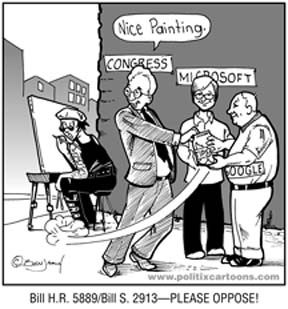
I encourage you to become familiar with the bill and take action accordingly. Your rights may be fading away without you even knowing it. If you would like to have your voice heard, The Illustrators Partnership of America has made it quite easy to take action. You can go to the web site and send an email, but faxes and letters are also encouraged. Please keep coming back for further information on this subject and send a link to this blog to other creative people that you know.
OTHER RESOURCES
Don’t take my word for it. You must decide how important this is to you. Here are some places to start.
- A wonderful resource of articles about this bill put out by the Illustrators’ Partnership
For comprehensive bill descriptions that describe the impact on visual artists:
House Bill http://capwiz.com/illustratorspartnership/issues/bills/?billid=11320236
Senate Bill http://capwiz.com/illustratorspartnership/issues/bills/?billid=11322171 - Video interview with brad Holland of the Illustrator’s Partnership
- American for the Arts on the Orphan words Legislation
- American Society of Media Photographs Update on 2008 Orphan Works Legislation
- Lawrence Lessig’s Op-Ed piece, in today’s New York Times
- Art Calendar article on the Orphan Works Act that also talks about Microsoft’s and Googles involvement.
- Public Knowledge concerning the Orphans work act
- Orphan Works Opposition Headquarters
- Plagiarism Today has several articles about the subject
- Attorney Tammy L Browning- Smith discusses the orphans works and Washington DC in her online blog Arts and crafts law
- Photography Director Rob Hagart discusses H.R.5889 ORPHAN WORKS ACT OF 2008 (INTRODUCED IN HOUSE) on his online blog
- An article from The Artist Foundation about the Orphan works Act
- The American Society of Media photographers throws in the towel and gets behind the bill, Johnathan Bailey describes why in this article ASMP Supports Orphan Works Bill. This site also has a video
- Mind Your Business: Don’t Lose the Rights to Your Artistic Creations, Animation World Magazine’s Mark Simon reports on alarming new developments in his continuing campaign against the Orphan Works Act.
- Why the Orphan Works Act is Uncles Sam’s Thieves’ Charter written by the Editorial photographers United Kingdom and Ireland
- A podcast with Alex Saviuk cartoonist of the spider man comics
Who Is Coming Up With Richard Hathaway?
I thought I would introduce you to Jenna, she is a sculpture that will be traveling on the road from Houston, Texas to Vermont. I need to deliver her to Main. Jenna’s mom is coming to the opening to pick up “her little angel.” I love the idea that we will be coming up to Vermont with an angel. I wonder if Jenna and Dick have met in heaven?
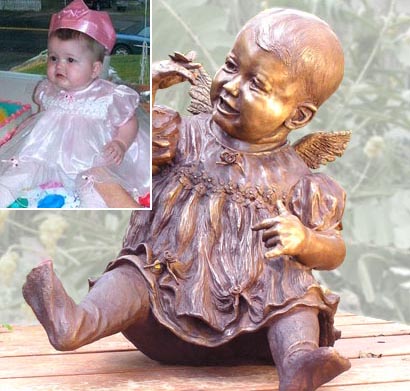
PLEASE MAKE PLANS FOR THE UNVEILING!
August 25th 2008, TW Wood Gallery. ( not sure of the time)
DATE IS BEING MOVED TO SEPTEMBER 25th 2008 5:30
There Is Nothing Like Molten Bronze!
June 10
The professors glasses are all fogged up!
While at the foundry dropping off the Jenna waxes and picking up wax two, I snapped these pictures of Dick Hathaway. Here you can see his head foot and…? The white stuff on the metal is the ceramic shell. The foundry will now break this away and begin to weld him back together again. Quite a process!
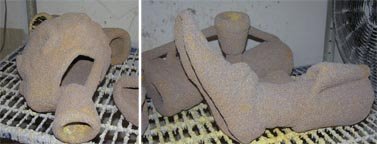
While at the foundry dropping of the Jenna waxes and picking up wax two I snapped these pictures of Dick Hathaway. Here you can see his head foot and…? The white stuff on the metal is the ceramic shell. The foundry will now break this away and begin to weld him back together again. Quite a process!
June 05
Today I went to see the pour of pieces of the Dick Hathaway sculpture. Here you see them pouring the head, in the background are the some other parts of the sculpture. You could say Dick Hathaway has a hot foot.
June 03
Richard Hathaway
Meanwhile I was able to take some pictures of Dick Hathaway, or at least pieces of him that have gone through the dip process. They are a bit different than the last pictures of the head.

Quite a shell around those wax pieces. If you have followed documentation process before you will note that inside these shells are the waxes. On Thursday the wax will be burned out of these shells until only a cavity remains. The molten bronze will be carefully poured within that cavity. The pour is scheduled for Thursday. I hope to get some good video footage of it for the upcoming video. I just love to watch a pour! There is something very entrancing about that glow!

May 29th
On with the bronze process of Professor Richard Hathaway
The next step, after the creating the waxes, is the gating of the waxes. Pour cups and wax sprues are added to the waxes that came from the Dick Hathaway molds. These are then dipped into a mixture coating the waxes both inside and out. Each of the many pieces will need to be dipped creating a ceramic shell. I went to the foundry today to take some pictures and video of the dip process for the next video that I will be creating about this sculpture. This part of the bronze process will take the foundry about a week.
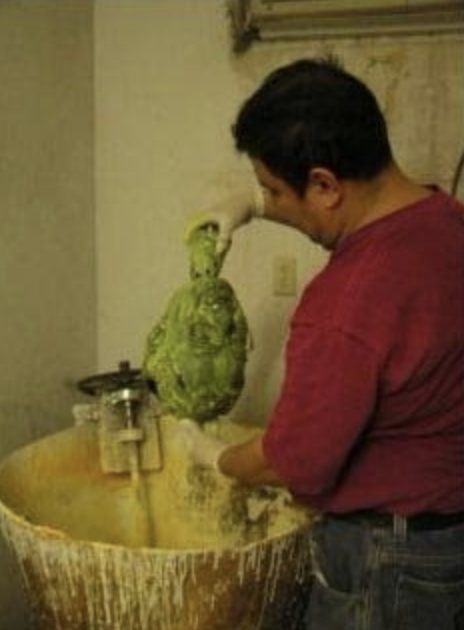
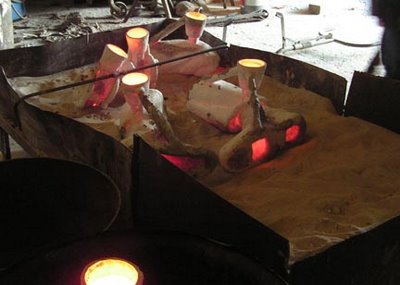
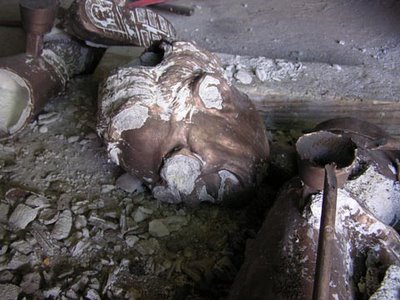
1/2 Way Through The Foundry Process
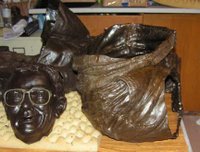
Once all the molds were made they were sent to the foundry and waxes were poured. The waxes are then brought back to the studio to be cleaned up. So here is Dick, gone to pieces! Now that the wax pieces are cleaned they are sent back to the foundry and they are gated up to get ready for the next steps in the lost wax method of bronze casting. I am so excited that Richard Hathaway is well on his way to becoming a bronze sculpture
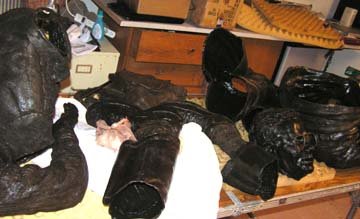
Off To The Foundry
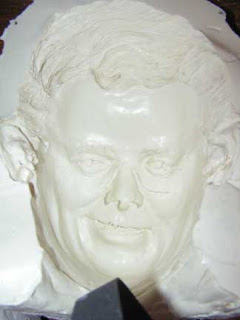
The 6 molds went to the foundry today. I always like taking a picture of the inside of the mold of the face. It looks so strange. I still have 3 more to make. Can’t wait for this week to be over with.
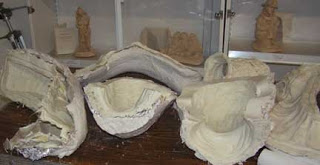
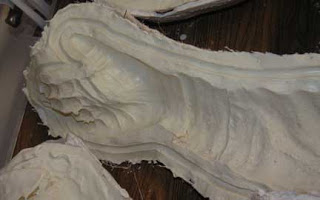
Messy, Messy, Messy!
Once shims are put into the sculpture to create a parting line the rubber is painted on. Then each side receives the mother mold made of plaster. My hands go through a dry week as I mix each batch of plaster with my hands. When it kicks and begins to cure it does so very quickly. The means haste in putting on the coat of plaster. This is why my studio is an absolute disaster right now. Plaster is everywhere, including spots on the cabinets, the phone, the tv remote and all over me. Just a few more days of this mess. That is not a birds nest on professor Hathaway’s rubber face, it is hemp that is added to the plaster to make it strong.
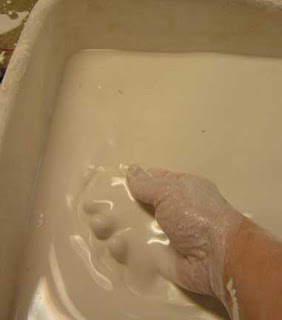
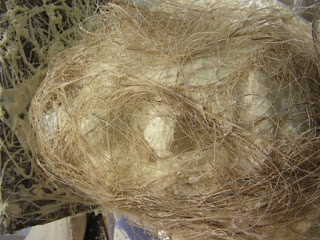
Professor Hathaway Has Gone To Pieces! This Is Not For The Weak of Heart
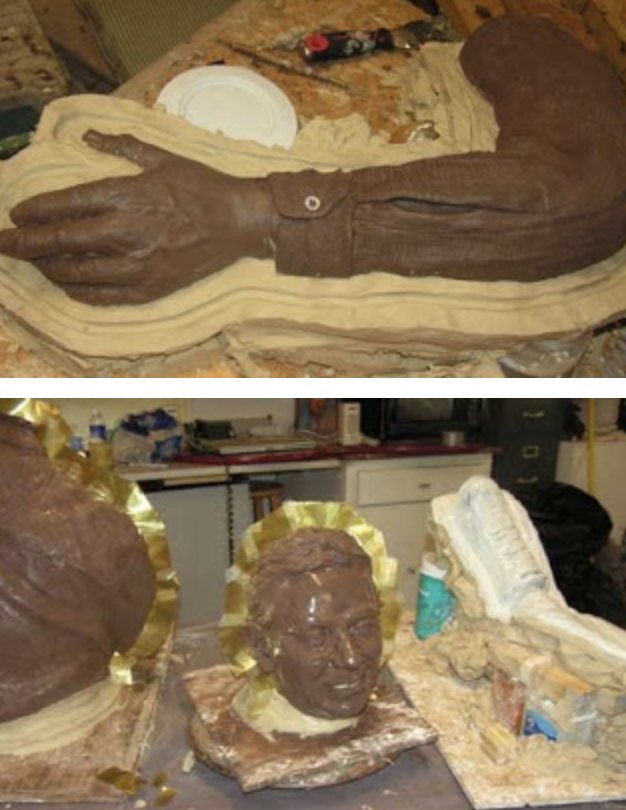
It is all part of the process. Not for the weak of heart. We have spent many months perfecting the sculpture only to cut it to pieces in the end. Each of these pieces will have rubber painted on top of them. Then a mother mold is added on top. They call it a mother mold because it holds the rubber in place. This process is grueling work. It will probably take me an entire week of long hours to complete all of the molds. The sculpture is cut up into 9 pieces.
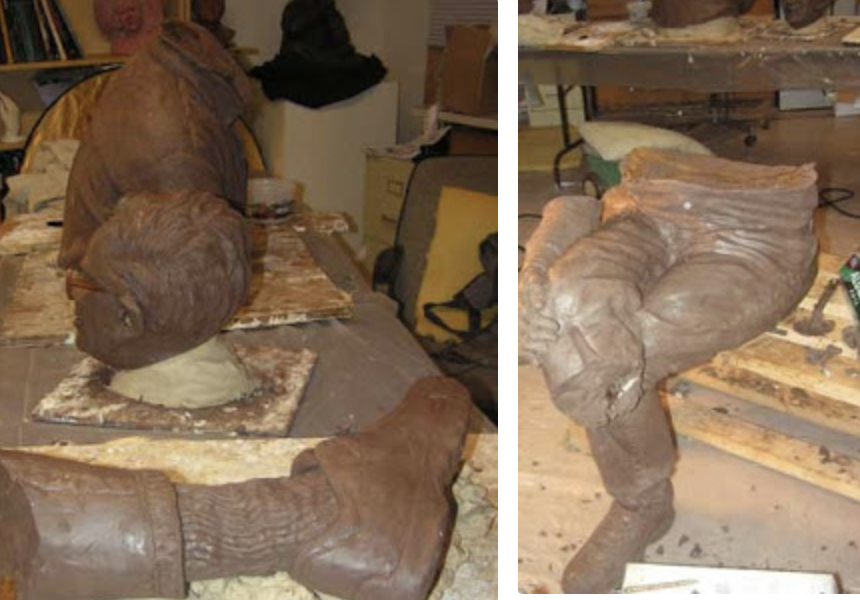
Off With His Head, His Arms And…

My apprentice, Russo, and I began the mold making process of the Dick Hathaway sculpture which consists of cutting him up into smaller sections. This freaked Russo out, especially when we cut off the head of the sculpture. My favorite tool in this process is my reciprocating saw. I love this tool, it also comes in handy when trying to divide plants in the garden! I laughed so hard at the expression on Russo’s face as we cut off the body parts and she handed them to me.

